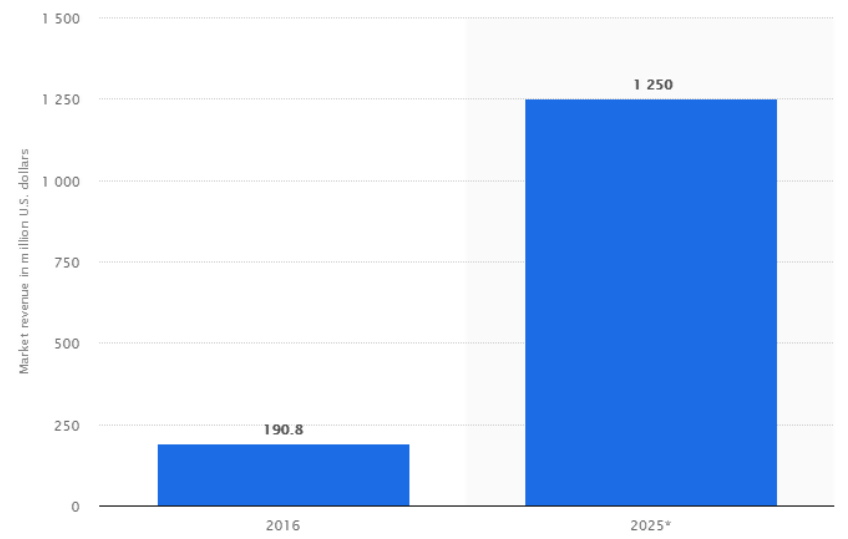Why should you follow chatbot marketing trends?
Everyone is talking about them and their potential for online businesses, but should you really invest your time and money in a chatbot?
After all, 80 percent of businesses are planning to use chatbots by 2020, which is incredible because this technology is comparably recent. And with artificial intelligence gaining momentum, chances are high that the adoption of chatbots will accelerate as they become increasingly useful.
The developments in the field of chatbot marketing will show how far chatbots have gone and how they can improve online marketing.
Trend #1: Strong Adoption
The number of online businesses using chatbots has been rising steadily in recent years, and this trend is likely to continue in 2019 as well. This is supported by research: for example, Statista claims that the chatbot market will grow from $190.8 million in 2016 to $1.25 billion by the end of 2025, which suggest that the pace of adoption will only accelerate in 2019 and probably beyond.

There are at least two major reasons fueling such impressive growth. First and foremost, chatbots become more functional, therefore, can meet the needs of businesses more effectively while reducing investments. Second, developing a chatbot becomes increasingly accessible for businesses, as they become more affordable.
Trend #2: Chatbots Will Play An Increasing Role In Customer Support
At this point, chatbots have been adopted by numerous businesses – from meditation apps to pizzerias – and for a good reason. As LogMeIn 2018 AI Customer Experience Report showed, only about 49 percent of customer problems are solved on the first interaction, which supports the fact that customer service in many organizations is inefficient. Often, this leads to frustrated customers because they have to talk to multiple people to solve their issues.
Chatbots could improve the overall satisfaction of customers with the quality of support they receive, so many companies will take advantage of them. For example, here are the use cases for chatbots in customer support that will define their role in the field in the next few years:
- Chatbots can deal with routine queries that typically make up most service requests
- Chatbots make it easy and quick for customers to contact a business online and get a response right away
- Chatbots can define the nature of a customer request and redirect it to an appropriate support department (just like Dominos Australia’s chatbot did in the image below)

- Chatbots are effective in cases where customer requests are predictable; e.g. troubleshooting and cases where scripted answers could be provided
- Chatbot can reduce the workload for human operators and save costs for a business by eliminating the need to hire additional personnel to handle requests.
Trend #3: More Natural Conversations
Many people still avoid chatbots because they prefer to talk with real people from customer support. While it sounds like a legitimate reason, it won’t apply to many chatbots in 2019 because a lot of effort is being invested in making them more “human-like.”
For example, the developers improve the ability of chatbots to understand humans by using Natural Language Processing (NLP), which is basically a method based on the understanding of text using the contextual information. For example, technology powered by NLP is behind such popular gadgets as Amazon Alexa and helps it to meaningfully differentiate responses and find appropriate answers.
As NLP continues to develop, we can confidently claim that it will help chatbots to have more natural language, so a conversation with them will feel more like a conversation with a human.
Trend #4: Chatbots Will Get More Attention From Businesses
In 2019, organizations will continue to research business applications of chatbots beyond customer service and find other ways of how they can help, including marketing and sales applications. Business leaders and researchers from various business branches are already exploring potential gains provided by chatbots.
For example, Richard Socher, Salesforce’s chief scientist, is one of them. Forbes has recently interviewed him about the importance of NLP-powered chatbots, and here’s what he had to say:
“NLP is going to be incredibly important for business – it is going to fundamentally change how we provide services, how we understand sales processes and how we do marketing.
“Particularly on social media, you need NLP to understand the sentiment around your marketing messages and how people perceive your brand.”
Obviously, the research into business applications of chatbots is in progress, so it’s safe to assume that more companies will follow suit of the early adopters to avoid being left behind.
Trend #5: Chatbots Will Help With Content Marketing
One important business application of chatbots that is likely to take off this year is content marketing. A chatbot is an excellent tool for reaching customers directly and supply them with content based on their preferences, so chatbot marketing is often employed to make communication with customers more relevant.
There are several ways in which chatbots and enhance content marketing strategies for businesses:
- Reduce barriers to direct communication. A chatbot provides an easy and effective way to connect with a business, which, for example, eliminates the need to install an app
- Provide customers and leads with relevant content. A business can send personalized content via a chatbot, thus maximizing the chance that the people will read it
- Ask for content ideas from customers. A business can provide a chatbot with some questions regarding product preferences, blog ideas, product suggestions, tips, frequent problems that users encounter while using a specific product or service, and so on.
For example, Sephora’s Kik chatbot offers the users a quiz that asks about product preferences and provides beauty-related tips.
Wrapping Up
The use of chatbots by businesses is rapidly increasing, and it’s safe to assume that they will play an important role in customer service, marketing, sales, and other fields. It makes perfect sense to use a solution that can reduce costs and improve business effort in a way that a chatbot does, so the future looks bright for the technology.
Subscribe
Related Blogs
Why should you prioritize lean digital in your company?

We are living in an era where the change and innovation rate is just so high. If you want your organization to reach new…
How to measure your open source program’s success?

Along with active participation, it is very important to look after the ROI of open-source projects, programs, and…
Understanding the significance of participating in open-source communities

Do you think contributing to the open source community can be difficult? I don’t think so. Do you have to be employed by a…



